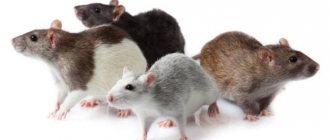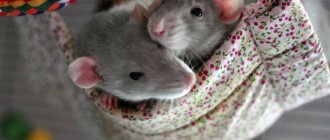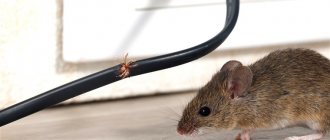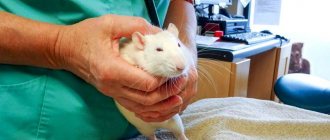What distinguishes a rat from all other rodents is not just cunning, a lively mind and quick wit. As zoologists have found out, the rat is still laughing! Certain sounds that these mammals can make resemble giggling. Moreover, of all the known representatives of the fauna of the Earth, only people and these cute rodents know how to laugh, doing it consciously. Scientists have long established that the genomes of humans and rats are 95% similar. How can the owner make his tailed pet laugh and enjoy the funny smile on his beloved face?
Reasons why a rat laughs
To bring a smile to your pet’s favorite face, you can tickle:
- along the inner surface of the paws,
- feet,
- tummy,
- behind the ears.
Most often, your ward will react in the same way as a person. Tickling is pleasant for the little rodent; she enjoys the process, while emitting contented squeaks. One gets the full impression that the cute animal is giggling with pleasure. Many of those who keep decorative rats assure that this is the most real smile.
The little creature bursts into joyful laughter not only from the tickling of sensitive areas on the body. Observing the behavior of a rodent in order to establish for certain whether rats can laugh, zoologists made another amazing discovery: animals laugh while playing with their fellow creatures or simply looking at the antics of others.
According to researchers, a decorative rat is more likely to choose as a marriage partner a relative who knows how to laugh and does it more often than others.
In a trap
Together with her colleagues, Professor Mason set up an experiment in which one rat was trapped in a pipe and its cagemate was released into an “arena” where only a free rat could open the door. The initial study showed that for a short period of time, the free rat tried to find a way to help its cage mate.
For 12 days, the free rat studied the mechanism and finally figured out how to open the door. She released her fellow tribesman and they were inseparable for almost a week. Moreover, the liberating rat followed the liberated one everywhere and periodically began to jump in place, as if rejoicing at its ingenuity.
Sounds of communication
When expressing feelings and mood vocally, the tonality and nature of the sounds produced by a rodent are diverse. For example, by squealing or chirping, your pet shows that it is scared or feels discomfort. Hissing expresses hostility and aggression. If your pet starts hissing, it is better not to disturb him. He is capable of biting the owner, moreover, this negatively affects the state of his nervous system. The animal will refuse food and may even bite its cage neighbors.
If the little tailed friend is in a good mood, then the new owner, who has previously had no experience in handling decorative rodents, will be able to personally see in practice whether the rats are laughing. Laughter will be an expression of delight and joy from communicating with a person or relatives: characteristic sounds - the pet will squeak or grunt a little.
Scientific experiments
They show that rats are capable of empathy even with unfamiliar individuals. This debunks the myth that only the higher mind is capable of emotion and empathy. The study was conducted over several years and included several experiments, and was led by neurobiology professor Peggy Mason. By the way, before that she studied the cellular mechanisms of pain modulation, but now she has switched her attention to the biological basis of empathy and mutual assistance.
The first experiment began in 2007. The researchers wanted to find out whether rats were “infected” by their general mood. This can be explained using the example of children: when one child cries, other children cry. However, they wanted to dig deeper and see if rats could go beyond empathy. That is, not just succumb to the general mood, but, as it were, overpower yourself in order to help everyone else.
How to visually recognize that a rat is laughing
Watching decorative rats is great pleasure and entertainment. If someone wants to have such an animal, but is not quite sure about it yet, you can play the multi-platform computer role-playing game “Laughing Rat Skyrim” and finally decide to go to the pet store for a funny live pet.
As some studies have shown, these rodents can express a smile with their ears. If you tickle an animal's tummy or paws, its ears will turn red and become limp. Zoologists explained this phenomenon by the fact that when rats experience positive emotions, they relax, and blood flows intensely to their ears, which is why they noticeably turn red.
Decorative rats, bred for home keeping, are sociable, curious, and affectionate creatures. With proper care of the pet, sincere love and attention to it, the cute animal will often delight the owner in return with a contented, funny smile and cheerful laughter.
Did you like the article? Share with friends: [supsystic-social-sharing id=”1"]
- Related Posts
- How long do pet rats sleep?
- Porphyrin in rats. Is it dangerous?
- What to do if your pet rat escapes from its cage
« Previous entry
Repeated experience
The same two rats were returned to their previous positions. A rat, once in the “arena,” almost immediately releases its trapped cage mate. The researchers took their experiment one step further by placing 2 containers in the space, one containing a captured rat and the other containing 5 chocolate chips. The team monitoring the experiment were shocked when the free rat not only opened both containers without much effort, but also shared treats with the freed rat. And this is instead of first opening the container of chocolate and keeping all the treats for yourself.
Bone tissue injuries
The most common injury is a broken tail in a rat, which occurs as a result of being pinched by a cage door. It is not uncommon for owners or family members to unintentionally step on a rodent.
Veterinarians are confident that if a rat breaks its tail and is examined by a specialist in time, breeders can rest assured. Typically, the broken part must be amputated, but in rare cases the animal may chew it off. If a wound is found on the tail, the area is treated with a weak solution of potassium permanganate.
If the owner accidentally steps on a rat and the animal is injured, it is important to act quickly:
- place the animal on a flat surface;
- if a rodent has broken its spine, it will drag its hind legs;
- when an animal drags one paw, then we are talking about a fracture of the limb.
The exact type of damage is only visible on x-rays. If a spinal fracture is suspected in a rat, the rodent is placed in a small box and covered with cotton wool. If an animal has a broken leg, it is permissible to apply a splint made from a flat stick above the fracture site.
After initial measures, it is necessary to take an x-ray of the rat’s paw fracture so that the doctor can make an accurate diagnosis.
The last proof
To further prove his point that rats are driven by empathy, Professor Mason conducted another experiment. The free rodents were given a sedative and then did not release the captured rat. The researchers concluded that because the free individual could no longer sense stress, it did not understand what the trapped fellow was feeling and did not feel the need to free her.
Skin injuries
While playing or walking around the house, it is important for owners to keep an eye on their pet to protect it from fractures and soft tissue injuries. Remember that rodent skin is very sensitive and can be damaged by awkward movements.
If a rat has skinned its tail, treat the surface with a disinfectant and visit a doctor. In some cases, the area needs to be amputated, but with proper and timely treatment, the tissue is restored.
When several animals are in the same cage, it is important for owners to monitor the behavior of their pets so that during play they do not tear off the skin or cause injury to each other. During sleep, the animal may fall, so you should ensure that there are no thorny or dangerous objects
Active animals often receive burns and scratches on their tails and paws. If there is an open wound, it must be treated. If the area of skin that is scraped or damaged is significant, the wood litter should be replaced with a cloth to prevent infection.
Selectivity in relationships
Professor Mason continued her research on empathy and rats and presented even more surprising results. Her later experiments, conducted in 2014, showed that rats are “selective” about who they empathize with.
If they are not "familiar", a free rat will not free a trapped one. The study yielded the same results when the free rat was raised in isolation and not socialized with its mates. Essentially, this means that if a rat has never seen another member of its species, it will not open the door.
The study concluded that empathy was based on the rat's social experiences, but was not limited to individuals it knew. A free rat would help an alien if it ever crossed paths with it.
The somatosensory cortex is responsible for the “fear” of tickling in rats
In rats, the most “ticklish” area is the abdomen, the back is slightly less sensitive, and if you tickle a rat’s tail, it also laughs, but very restrainedly. Photo from newscientist.com
It turns out that if a rat is tickled in special places, it begins to “laugh.” Scientists have divided this “laughter” into characteristic components and determined the specifics of the reaction to tickling. It was possible to find out that rats make the same specific sounds during play behavior. Measurements from microelectrodes implanted in the somatosensory cortex, which is responsible for the “tickle” areas of the body, showed that both “laughter” and play behavior are controlled together in this part of the cortex. Under stressful conditions, neurons in this part of the cortex are inhibited, so neither laughter nor the desire to play arises in the rat. All this together resembles the reaction to tickling in humans, which means that studies on rats may help unravel the mysterious phenomenon of tickling.
Many have wondered why we laugh when we are tickled? After all, in reality this is not such a pleasant feeling, to say the least - completely unpleasant. Few adults rejoice when they poke him in the ribs, even playfully. The metaphorical expression “tickle to death” can turn into reality: we know that in medieval Europe and India tickling was used as a special torture, and the ruthless landowner Anfisa Porfiryevna in “Poshekhonskaya Antiquity” by M. E. Saltykov-Shchedrin ordered tickling as a sophisticated punishment the guilty maid “to the point of foaming at the mouth.”
On the other hand, laughter is an expression of joy, playful behavior, and it is precisely this that accompanies tickling, at least one of its types. All children, for example, love it when their parents or friends tickle them while playing. Let me remind you that there are two types of tickling - knismesis, that is, a sensation of light touches, and gargalesis, a sensation of rougher impacts on special “tickle” places on the body - under the armpits, along the ribs on the sides of the body, the soles of the feet and some others (see: Knismesis and gargalesis). Loud laughter, convulsive facial expressions, and contraction of the diaphragm muscles accompany only the second type of tickling, gargalesis.
Meanwhile, you can tickle yourself as much as you like without any thrill or spontaneous laughter; here you need a tickling partner. This raises the question: what is tickling - a type of social interaction with a positive connotation, or a special involuntary reflex associated with joy in a very indirect way?
Scientists are inclined to favor the second hypothesis - reflex. They already have enough evidence for this. Firstly, laughter in response to tickling appears outside of play or social situations, and if a person does not see the tickler’s face. So, back in the 40s, physiologist Clarence Leuba tried to tickle his small children while wearing a mask that covered his face. He tried to find out whether laughter occurs in response to a joyful expression in an adult playing. It turned out that to excite laughter during tickling, a smile and joy on the parent’s face are not required at all.
More accurate and interesting experiments were performed later by Christina Harris and Nicholas Christenfield from the University of California at San Diego (CR Harris, N. Christenfeld, 1999. Can a machine tickle?). In these experiments, conducted on students, scientists found out how significant the social component is in the emergence of a reaction to tickling. Let two people tickle in turn: a man and a machine. The difference in response to this tickling will indicate what role is assigned to the partner. Presumably, if the social component is high, then the behavioral response to machine tickling should be reduced compared to tickling by a human partner.
For this experiment - and the phenomenon of gargalesis was studied - the scientists constructed a model of a tickling machine (in these experiments, the subjects were tickled under the ribs): an artificial hand with fingers, a pipe from a vacuum cleaner to simulate finger movements, and a medical nebulizer that reproduced the sounds of the partner's breathing were attached to it . It looked like a pretty decent imitation. But in both cases—the “machine” and the “human”—it was actually the experimenter hidden under the table who was tickling. Thus, scientists avoided differences in the actions of machines and humans. The subjects, however, did not know about this, so in a subsequent survey they noted that they clearly distinguished between the tickling of the machine and the experimenter by the clear rhythm of the movements of the machine, by the sensations from the nails on the experimenter’s fingers, and other important details. It remains to compare the characteristics of laughter and contractions of various muscles in response to pseudo-machine and human tickling. No differences emerged. Thus, it was shown that the social component of gargalesis is minimal.
It was also experimentally found that gargalesis has little to do with actually humorous, cheerful laughter. Such laughter is known to be contagious, and once you start laughing, it is difficult to stop. We laugh more and more readily when jokes follow one another, and at the last ones we almost cry with laughter. (This is partly why comedy performers prefer to be in the middle or at the end of the performance.) This is due to the potentiation of the neurons responsible for the laughter response, which lowers their threshold for firing, so that laughter begins even with minimal arousal.
Does such potentiation exist in the case of laughter caused by tickling? You can check: first tickle a person, and then present him with funny situations, or vice versa - first humorous situations, and then tickle him. And in the control version - show two funny situations in a row. This was done, and the result was clear: no potentiation occurs during tickling (CR Harris, N. Cristenfeld, 1997. Humour, Tickle and the Darwin-Hecker Hypothesis).
Since gargalesis has little to do with fun, we should turn to the study of tickling in the light of reflexive ideas. What kind of reflex is this strange - both laughter and tears? How did it arise and why? If the reader hopes to find in this note a definite answer to these intriguing questions, then read no further. But I will nevertheless present some interesting new information. These results were published in the journal Science
two neurophysiologists from the University of Berlin. Humboldt (see also video describing the results of the study).
This publication is based on a study of gargalesis in rats. Precisely rats, not humans. It was known that not only humans, but also apes laugh in response to tickling. True, their laughter is different from human laughter, but, nevertheless, it is recognizable. Also, at the end of the twentieth century, evidence appeared that not only people and monkeys, but also rats, when tickled, emit a certain ultrasonic signal with a frequency of 50 kHz (J. Panksepp, J Burgdorf, 2003. “Laughing” rats and the evolutionary antecedents of human joy? ). This signal can be considered as an analogue of laughter, since it is associated with play behavior in rats, especially in rat pups. This means that the tickling phenomenon can be studied not only in humans, but also in rats. And this is important not only from the point of view of comparisons of this interesting behavioral reflex, but also from the point of view of anatomy - you can find out what happens in the brain when tickled.
The rats' repertoire of auditory signaling and tickling behavior was measured, as well as their associated excitations in the somatosensory cortex, where sensory signals from the skin, including tickling, are processed in all mammals. To do this, a microelectrode was implanted into the part of the somatosensory cortex where information from the abdomen is collected and processed. This way it was possible to determine the level of excitation of neurons in different layers of this area of the cortex.
Rice. 1.
Characteristic sound signals when tickling.
From left to right:
modulated signal, trill signal and combined signal.
Figure from the discussed article in Science
When tickled, rats emit several characteristic signals with frequencies around 50 kHz - trill, modulated and combined signals (Fig. 1). The most signals were recorded when the abdomen was tickled: the intervals between bursts of laughter were shortened by approximately two times compared to stimulation of the back. At the same time, they are more diverse - all three types of signals are found. In a word, the rats burst out laughing. The reaction when the back is tickled is slightly poorer: there are significantly fewer combined signals (Fig. 2). They are not there even when you lightly touch the back. During play behavior, combined signals appear, but compared to tickling the abdomen, their proportion is reduced due to a greater number of trills. Tickling apparently excites the rats because they continue to “laugh” even after the tickling is over, in between tickling sessions.
Rice. 2.
The ratio of sound signals in rats when tickling their tail (Tail tickling), belly (Ventral tickling) and during play behavior (Chasing hand).
Combined signals ( yellow
) are present during belly tickling and play behavior.
When the tail (or back) is tickled, the proportion of such signals is greatly reduced. Diagram from the discussed article in Science
When the abdomen is tickled, 77% of the neurons in the corresponding somatosensory area are excited; during play behavior, 87% of neurons in the same area are excited, and with a light touch - 67%. The strongest excitation of neurons is associated with combined signals.
The characteristic sound signals of “laughter” arise when the deep layers of the cortex are excited. This was tested by stimulating these layers by applying current to microelectrodes: electrical stimulation of only these deep layers caused the rats to laugh. And even more, after electrical stimulation, the signals of laughter from tickling increased significantly; the rat simply began to laugh, if we translate strict physiological characteristics into everyday language. In short, pre-stimulation of the neurons responsible for tickling lowers the threshold of sensitivity, increasing the response to tickling. Surprisingly, they stimulate not the auditory area at all, but the somatosensory area, but in return they receive an audio response. Moreover, it is highly specific, corresponding to tickling. There is clearly something to think about here.
In the second part of the experiment, we checked how the reaction to tickling manifests itself under stressful conditions - in an open, illuminated area (Fig. 3). If you tickle a rat's belly under such conditions, almost no laughter signals are registered.
Rice. 3.
Installations for the experiment under normal (Control) and stress (Anxiogenic) conditions.
The stress factor was the strong illumination of the area with the rat. Figure from the discussed article in Science
Under stressful conditions, the ratio of excited and inhibited neurons in the “tickle area” shifts towards inhibition. The fact is that under stress, tickling does not cause excitement, but, on the contrary, inhibition of the corresponding neurons. Therefore, a rat under stressful conditions does not laugh or play (Fig. 4). Well, we are familiar with this - try starting to tickle a person when he is preparing for an exam or an angry dog is attacking him. At best, you will get an angry reaction, but not a cheerful laugh.
Rice. 4.
Sound signals when tickling different parts of the body (D - back, V - abdomen, Dg - touching the back, Vg - touching the abdomen, T - tail, Ch - play behavior) under normal (Control) and stressful (Anxiogenic) conditions.
It is clear that under stressful conditions, rats are not amused. Figure from the discussed article in Science
An important aspect of the study that the authors emphasize is the connection between play behavior and tickling. It is expressed, firstly, in a similar sound design, enriched with combined signals, during play and tickling. Secondly, there is a similar pattern of excitation of neurons in the somatosensory area during tickling and play. Thirdly, in a change in expected reactions under stressful conditions, when both the sound reaction to tickling and play behavior are suppressed.
We see a characteristic behavioral triad in rats - tickling, special spontaneous laughter, the desire to play. All these reactions are interconnected and controlled by neurons in the deep layers of the somatosensory cortex. It is worth adding that, under normal conditions, tickling and the sensations associated with it are obviously pleasant, and are linked to the dopaminergic reward system. But under stressful conditions, this behavioral triad does not manifest itself, and the corresponding areas of the somatosensory cortex are not excited, but, on the contrary, are inhibited. Unpleasant sensations arise. All this is familiar to us from our own human experience, so we can fully understand rats. It is possible that rats will help us figure out this confusing matter of tickling, and we will finally unravel its mystery.
Sources:
1) S. Ishiyama and M. Brecht.
Neural correlates of ticklishness in the rat somatosensory cortex // Science
.
V. 354. P. 757–760. 2) Christine Harris. The mystery of ticklish laughter // American Scientist
. 1999. V. 84. P. 344.
Elena Naimark
Dream Interpretation - Bite
An animal bite in a dream foreshadows a quarrel or resentment. Feeling a bite in a dream means losses and worries. Such a dream often predicts domestic troubles and scandals. If you dream that you were bitten by some person, then do not hope to win in some controversial matter. A dream in which you bit someone foreshadows a serious illness or nervous shock. If you dream that you were bitten by a cat or dog, then be afraid of betrayal or quarrels with a loved one. If in a dream you are bitten by a person whom you knew before, then you will be haunted by difficult memories. See interpretation: Animals, Beasts, Teeth. The mark of teeth left behind after a bite means that the insult inflicted on you will be etched in your memory for a long time. If you see blood at the site of the bite, then you will be very worried about what happened. See interpretation: Blood.










